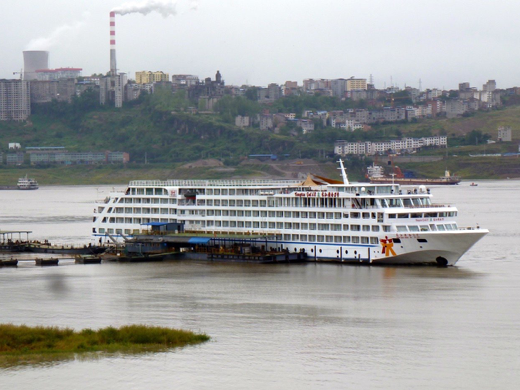On a Slow Boat Through China

On a Slow Boat Through China
It was 1951, and I was a passenger on a boat to Hong Kong. “On a Slow Boat to China” was playing time and time again throughout the vessel and it is still in my head today. And now we are on another Slow Boat, but sailing not to but through China. And the tune persists.
Cruising the Yangtze River through the Three Gorges is a popular option for the China traveler to enjoy stunning scenery in the relaxed atmosphere of a cruise boat. The Three Gorges area has been classified as a 5-star attraction by the Chinese National Tourist Administration. It helps to get tourists to take this tour. But it is indeed a worthwhile tour. You can go either downstream or go upstream between ChongQing and either Jingzhou or Wuhan. Either way, you will be going through three spectacular gorges through which the Yangtze river flows. Well, they were really spectacular a few decades ago, but since the Three Gorges Dam was built the level of the water in the river is now much higher and controlled. It now rises to substantially above what is used to be, drowning many little towns, interesting archeological areas and other structures in the process. It is still spectacular, but not as much as it used to be.
The rising waters has increased the width of the streams, reducing the surface speed of the water, as well as reducing the height of the towering canyons as observed from the water. Of these three gorges the Xiling gorge, the third one, has essentially been emasculated. The big dam has been built right at the Eastern end of this gorge.
One result was that the wider and deeper river now allows the use of larger boats; and thus the luxury behemoth cruise ships appeared and cruising the Yangtze became a standard word in the tourist lexicon of China. And the scenery is still spectacular, especially if you have never seen it before the dams were built. As the waters rise and the streams become more placed, there is at least one new, spectacular, attraction created. This is the Goddess Stream, on the south bank of the Yangtze, opposite the Goddess Peak of the Wu Gorge. This used to be a gentle brook, but it is now a navigable arm of the river, with high, steep, towering cliffs on both sides.
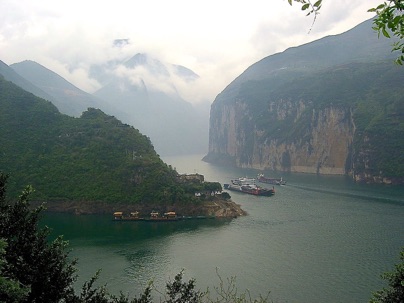
right: "The Qutang Gorge along the Yangtze river" by Chen Hualin
We have been on this cruise four times; in 1985, in 1995, in 2015, and now, in 2017. This narrative covers observations from all of these journeys. Our next trip down the Yangtze will be sometime in the hazy future, when I probably will not be much wiser than I am now.
The journal may be somewhat confusing because I wanted to juxtaposition my experiences and the differences on the four different trips I took, instead of writing four separate articles, one for each journey. I hope you bear with me as I jump from one trip to another during the description of comparable issues.
I: ChongQing.
1985
On all three trips we flew into ChongQing, which was still sometimes called Chungking when we came there in 1985. The city was the temporary capital of the country during the Sino-Japanese conflict, and had been heavily damaged by Japanese bombers during that time. War-related ruins were still visible in many places. There was a very heavy haze over the city caused by pollution from coal-derived power plants.
1995
Our second trip was in September of 1995, when we flew in from Xian in a 50-passenger Russian turboprop. I am not sure I would care to make a living flying those planes. I remember that the passengers were all presented with a Chinese folding fan at check-in, which I thought was very nice of them. We found out later that the air-conditioning in the plane was not working and we needed those fans to cool off a bit. Chongqing is very hilly and you therefore see few bicycles and no fat people. It is an amazing observation because in other cities in China, there are zillions of bicycles everywhere. We did not see any more war-related ruins around. but in the mountains around the city there are still a number of air-raid shelters visible.
Chongqing is also a clean city. One of its suburbs had been voted as the cleanest city in the country. The streets are washed at night. If you have stuff to move around, you hire a porter. There are many porters on the streets with a pole on their shoulders offering their services to the public and it is amazing how much they can carry. Patrons of course have a tendency to have them carry as much as possible per trip. And bargain with them for the cheapest rate possible.
There are few motorcycles around, even though there seems to be 3 motorcycle assembly plants in the area. The problem is parking. Building land is precious, so buildings are almost all multistoried. It is no fun lugging your motorcycles up the stairs each night if you do not want to have it stolen, especially since most of the buildings do not have any elevators. Only luxury apartments and post 1948-buildings with more than 8 stories have elevators. The most popular mode of transportation is the No. 11 bus, i.e. on both of your legs.
2015
On our third trip in September 2015, we were astounded at the developments which had taken place in the 20-year hiatus. More buildings, most of them modern and substantially higher than the 8-story benchmark two decades ago. Many-storied apartment buildings abound. The city is still hilly and still very clean; there are still few bicycles and motorcycles around. There are many more cars around, but the major thoroughfares have been widened. The city has grown tremendously and now is home to 32 million persons. The city has more inhabitants than many countries in the world.
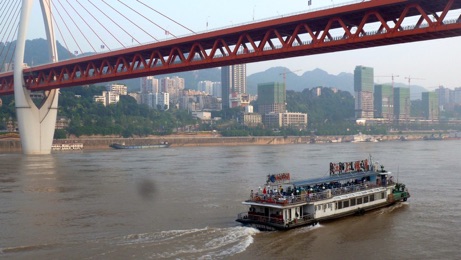
left: A bridge over the Yangtze river at Chongqing. The top level is for automobile traffic. The second level is for the subway and/or monorail transport systems. In the foreground is a sightseeing vessel. It is almost impossible to see on this picture, but there is a gondola high up between the bridge and the sightseeing boat in the background.
To move these people around the city has buses, trains, freeways, subways, monorail systems and a number of new bridges over the Yangtze. There is even, high in the air, a gondola for pedestrian transport over the river. The subway system was said to be good, very fast and comprehensive.
II: The Chongqing zoo.
2015 and 2017
In the few hours between arrival in Chongqing airport and boarding our cruise vessel, we had lunch, which happened to be in the same restaurant in both years. Problems with the elevator in 2015 were still there in 2017. But in 2017 the food was considerably better.
Back in the bus to visit the Chongqing zoo to see their pandas. It was raining when we arrived there in 2017, but an umbrella vendor was waiting for us at the exit of the bus to offer us her umbrellas at RMB 10 each (US$ 1.40) It is surprising that at that price she could still make a profit and a living. Since it was raining, she should have charged twice as much, and tourists would still have gladly paid.
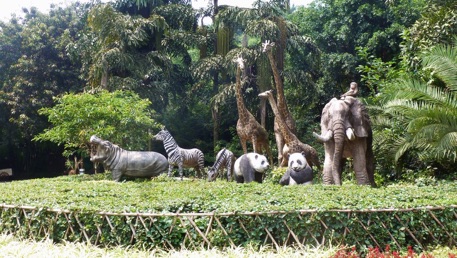
left: At the entrance to the Chongqing zoo. These animals are friendly but fake.
The city has a nicely landscaped zoo and it has pandas as the premier attraction. There is a lot of shade, which is very nice, because it can be hot and muggy, as on the day we were there. So, if you go there, I suggest you take an umbrella for the sun. Or for the rain, if the weather is inclement.
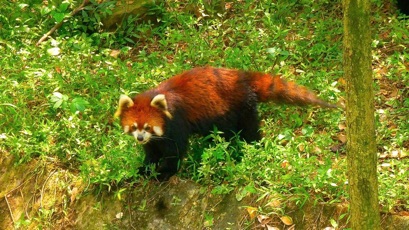
Most people, including us, did not know that the panda family also encompassed subspecies which do not look like the pandas we know.
right: This is a “lesser” panda, a small animal the size of a large cat, with a ringed tail like a raccoon, but apparently also a member of the panda family.
But there was Liang Liang, the panda who is also the star of the zoo. He was moving very slowly around, occasionally taking a nibble from the stack of bamboo at his disposal. Pandas are cute.
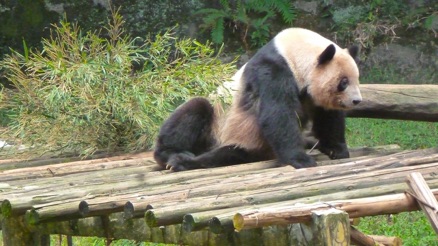
left: And this is Liang Liang. Our guide claims Liang Liang is lazy, but if you are cooped in a small place you might as well take it easy and be labeled lazy. Besides, you don’t have to forage for food. All the bamboo you need will be delivered to you.
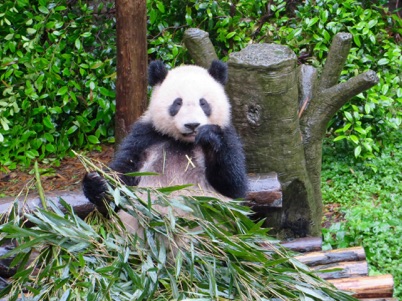
right: And here is lovable TinTin, an offspring of Liang Liang and Yaya, named after the main character in the cartoon series “Les Aventures de TinTin” by Georges Remi, Just like his Dad, he enjoys the bamboo served to him, even though he is only about one and a half years old, when this picture was taken. He was born in captivity, so their breeding program works very well.
There are, of course, also a large number of other animals on display. An amazing exhibit is that of the specially bred goldfishes in the aquariums in the Fish House, which many of the occasional visitor will miss. And I am not talking about the many goldfish in the open air ponds.
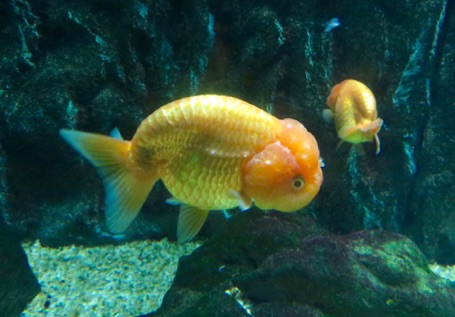
left: this goldfish has been bred to have a large “helmet” on his head
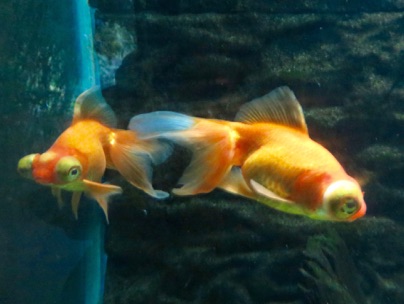
right: And this one is bred to have huge protruding eyes.
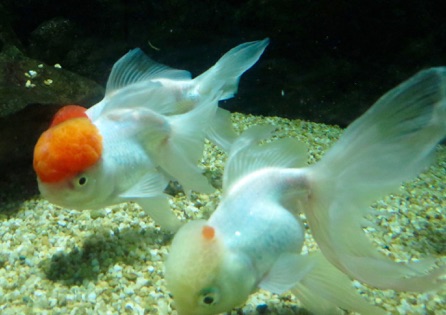
left: These goldfish are white, both have “helmets”; but one of these is yellow-gold, the other one white with a speck of orange.
Further away in the zoo we entered the area of the larger animals.
The enclosures for these animals do appear to be on the small size, especially for the large species, such as the hippos, lions, and tigers who are used to living on miles and miles of land. A few hundred square meters or so enclosure is much too small for them. They don’t seem to look too happy either.
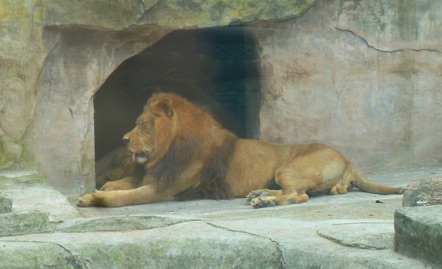
right: When we were there, this lion was roaring like mad to vent his frustration.
The zoo is otherwise a pleasant place to walk and amble around. There are many kiosks where you can purchase water and snacks. There were not too many visitors when we were there.
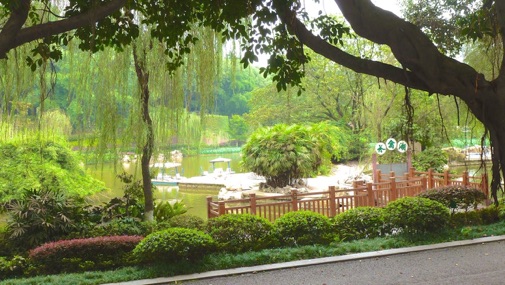
left: This is a lake around a playground


